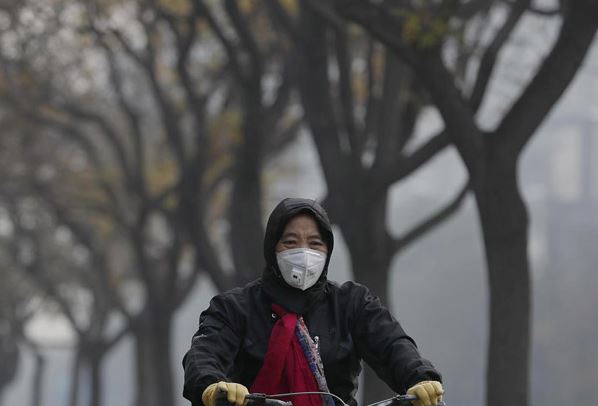
From the People's Daily app.
And this is Story in the Story.
China's weather was generally stable in 2018 and the nation experienced significantly less weather-related damage and fewer deaths and injuries than in recent years, according to the China Meteorological Administration.
Phenomena such as rainstorms, floods, droughts and dust storms were less severe than usual last year, according to the 2018 China Climate Bulletin.
Natural disasters killed 635 people, damaged around 21 million hectares of crops, and led to direct economic losses of more than 264.5 billion yuan ($38.8 billion) last year, the report said.
Still, compared with average figures from 2013 to 2017, all three categories saw a major drop overall. In two areas-typhoons and extreme cold-casualties and economic damage were higher than usual last year.
Today's story in the story looks at the weather patterns of the last 12 months and what we might expect this year.
A cyclist rides on a flooded road caused by heavy rainstorm in Tongzhou district, Beijing, August 8, 2018. (Photo: IC)
The number of typhoons that reached China rose in 2018 and the places they came ashore were more to the north, hitting some of China's most economically vibrant regions, said Zhang Qiang, deputy director of the National Climate Center.
Between 1949 and 2017, only six typhoons hit Shanghai. From late July to August, however, the city was struck by four typhoons.
That included Rumbia, the typhoon that caused the most damage in China, affecting over 18 million people in seven provinces.
Temperatures and precipitation were also slightly above average last year, Zhang said. The national average temperature last year was around 10.1 C, which was 0.5 C higher than the average from 1981 to 2010.
Many parts of China saw record high temperatures, especially during spring and summer. The number of high-temperature days (at 35 C or above) was also the second highest in history, reaching 11.8 days, second only to 2017.
This year, forecasters say that El Nino, a global climate phenomenon characterized by warming surface waters in the Pacific Ocean, might reach its peak in early spring, Zhang said.
That might bring more precipitation to eastern and southern parts of China, while northern regions might see less rain, he said. "El Nino is one of the main factors affecting China's climate, so we have to keep closely monitoring the situation."
The last El Niño was in 2016, the hottest year on record. The coming El Niño is not predicted to be as strong, but even so, it can still significantly affect rainfall and temperature patterns in many regions.
The National Observatory said China will experience a warmer than normal winter, and some areas in the north will be more prone to air pollution as a result.

Smog blankets Beijing on November 3, 2018. (Photo: VCG)
"Generally, the average temperature in winter will be higher than average. The possibility of wide-ranging and long-lasting freezing snow and rain is low, " said Ai Wanxiu, chief forecaster at the National Climate Center.
She said, however, that people should follow the weather forecasts, as there may be short-term cold spells.
The higher temperatures this winter may also worsen the ongoing drought in some areas, including areas in northern and southwestern China, Ai said.
"Little rainfall is forecast in these areas," she said.
To improve the accuracy of weather forecasting and provide better meteorological services to countries participating in the Belt and Road Initiative, China launched the new Fengyun-2H meteorological satellite last year.
Equipped with a scanning radiometer and space environment monitor, Fengyun-2H will provide real time cloud and water vapor images and space weather information to clients in the Asia-Pacific region, said Wei Caiying, chief commander of the ground application system of Fengyun-2H and deputy director of the National Satellite Meteorological Center.
The Belt and Road region, which is mainly high mountains, deserts and oceans, lacks meteorological information. Damage from natural disasters, especially meteorological disasters, in the region is more than double the world average.
China already has 17 Fengyun series meteorological satellites in space, with eight in operation, including five in geostationary orbit and three in polar orbit, to observe extreme weather, climate and environment events around the globe.
The World Meteorological Organization (WMO) has included China's Fengyun series of satellites as a major part of the global Earth observation system. They provide data to clients in more than 80 countries and regions. Weather forecasts in the eastern hemisphere depend mainly on China's meteorological satellites, according to the CNSA.
(Produced by Nancy Yan Xu, Brian Lowe, Lance Crayon, Elaine Yue Lin, and Chelle Wenqian Zeng. Music by: bensound.com. Text from China Daily, China Plus.)


